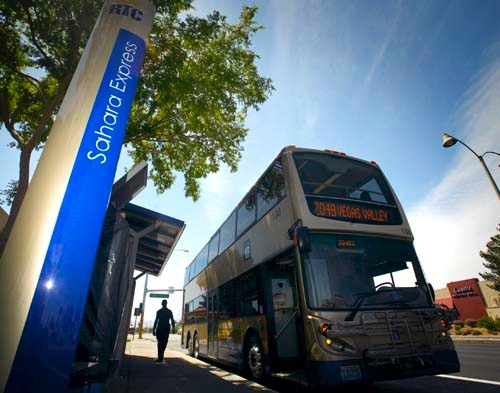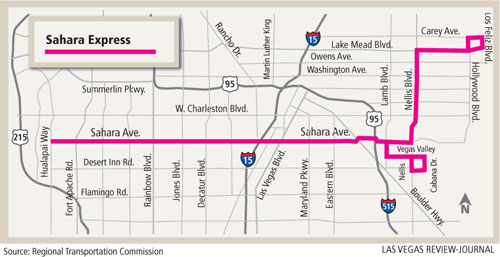Express bus route on Sahara ready to ride
Wrap up the nightmare on Sahara Avenue. It's finally over.
And that news must be pleasing not only to motorists frustrated by lane restrictions and horrid backups, but also to business operators who, on top of a disastrous economy, had to deal with orange cones blocking their entrances for more than a year.
Imagine how small startup businesses suffered if the construction of the Regional Transportation Commission's designated bus lanes was tough on an old establishment like Big Dog's Cafe and Casino.
Vicki Egan, manager of the West Sahara pub, applauded the transportation agency for communicating with businesses regularly about upcoming road work. Even though she appreciated the face-lift on Sahara, it wasn't easy to watch lunch crowds at the bar thin out over the months.
"It's hard to get frustrated when they're trying to improve the street," Egan said. "But it hurt business because people couldn't get up and down Sahara; you couldn't get in or out from any direction. It was slow for a while, but people are coming back."
NEW ROUTE PRAISED
On Monday, dignitaries and representatives of the commission announced the completion of the Sahara Avenue Express route, which will allow buses to travel in designated lanes between Hualapai Way to the west and Lamb Boulevard to the east.
The latest bus rapid transit is far more efficient than a traditional route thanks to newer technology. The vehicles are equipped with software that sends a message to traffic signals, notifying the light's control box of their location. The signal will turn green if it can do so without disrupting traffic flow on other streets feeding into the intersection.
The designated lanes will allow the vehicles to move smoothly on Sahara even when traffic is backed up in the regular travel lanes. The trip from Fort Apache Road to Lamb, for example, now takes an average of 58 minutes; that same ride will now take about 48 minutes.
The new system will be implemented on Sunday.
Commission Chairman Larry Brown said public transit agencies are turning more toward bus rapid transit systems, a cheaper option than light rail.
"We are ahead of the trend," Brown said. "If you give us the opportunity to get you on one of our buses, we will sell you on it."
BOULDER EXPRESS CITED
The concept appears to be popular. In September, the Regional Transportation Commission opened its Boulder Highway Express line between Henderson and downtown Las Vegas. The route is complete with designated lanes and the same signal activation system. Its ridership jumped from 194,000 passengers per month to 354,000 riders. The higher figure included the extension into downtown Henderson, which was added when the new route opened.
"When we make these types of investments, we see an increase in ridership," commission spokeswoman Tracy Bower said. "The dedicated lanes make it more efficient and that helps increase ridership."
Like the Boulder Highway and downtown express routes, Sahara will not only have designated bus lanes that private vehicles are prohibited from using, but they also will have ticket machines at the bus shelters. The express lanes have fewer stops, typically one-third a mile apart rather than a quarter of a mile.
THE GOOD, THE BAD
Businesses and residents along Sahara have suffered throughout the 15 months it took to finish the $40 million project, which also included the widening of sidewalks, and the construction of 70 solar-powered bus shelters and landscaped medians.
The nuisance of the construction and lane closures was the downside; that the project helped keep some 500 private-sector workers employed was the upside.
The commission received $35 million in federal stimulus funds and the remaining money came from local sales tax revenues.
Former Rep. Dina Titus, D-Nev., said she proudly voted in favor of the controversial package and noted that two years later, hundreds of Nevadans are still at work because of it.
"In Nevada politics, you really get to see the fruit of your labor," she said.
Politicians accustomed to having plenty of money have had to adjust to the tighter coffers and set different priorities over the past several years, Clark County Commissioner Chris Giunchigliani said. The Sahara project was well worth the money because it provides a more efficient commute for passengers, and less idling for buses is far better for the air quality, she said.
The freshly completed work also will benefit motorists. Crews installed updated software and fiber optic cables along Sahara so that the traffic signals will be better coordinated by the Freeway and Arterial System of Transportation.
Sahara carries between 40,000 and 60,000 motorists a day. The new software is expected to improve the synchronization of traffic signals, moving traffic more fluidly through some of the densest areas of the city.
Contact reporter Adrienne Packer at apacker@reviewjournal.com or 702-387-2904.
See the route map.
By the numbers
$40 million
Cost of project
15
months to complete project
18
miles of designated bus lanes
70
solar-powered bus shelters
60,000
vehicles that travel Sahara per day


















